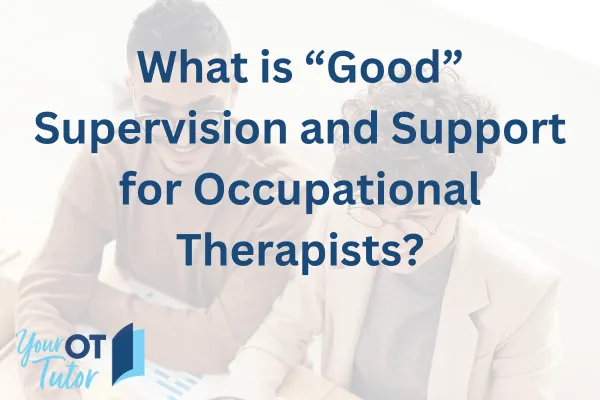THE YOUR OT TUTOR BLOG
Articles on important topics for occupational therapists...


What is “Good” Supervision and Support for Occupational Therapists?
With many occupational therapists experiencing work-related stress and burnout, one of the key protective factors is to find a workplace that offers good quality supervision and support.
But what is ‘good’ anyway? With OTs in hot demand in all sectors (let’s face it, finding an experienced senior OT is like a finding a unicorn at the moment!), clinicians no longer need to settle for below par support, or unfulfilled recruitment promises; instead, they can find an employer that will offer the supervision and support they deserve.
If you’re an OT looking for their first job, or a new job, or perhaps you’re weighing up whether what you feel you need is a reasonable expectation, this newsletter will give you a summary of the key aspects of good supervision and support for occupational therapists.
1. Formal clinical supervision
There are no hard and fast rules for how much supervision a therapist should have, but the consensus is that it should be individualised, based on the clinician’s level of experience, and the complexity of the caseload. Having said that, a common expectation is that any supervision session should be at least 1 hour long and they need to happen regularly. New graduates should receive supervision weekly, while experienced staff still need to be offered clinical supervision on a monthly basis – there is no such thing as “too experienced to need supervision.”
As I said before, senior OTs are unicorns, so even if the employer has the best intentions of offering this level of supervision, there may not be a suitable staff member to provide supervision within the workplace. In this instance, external clinical supervision options should be explored (paid for by the employer!). For experienced OTs, group and peer supervision options can be appropriate, but shouldn’t fully replace one-on-one sessions.
Clinical supervision needs to focus on challenges within your clinical caseload, reflections on your progress and areas for improvement, and development of professional resilience. Line-management specific tasks like KPI targets and planning leave are not the same as clinical supervision!
On top of formalised clinical supervision sessions, you should also be able to access ad hoc support whenever you need it, whether it’s someone to answer a quick question on the phone, or an experienced OT that can complete a joint treatment session with you for something new or complex. If you have the option to choose a workplace where this support is available onsite, strongly consider it, especially if you are a new grad!
For more info on clinical supervision, check out the HETI resource “The Superguide: A handbook for supervising allied health professionals (HETI): https://www.heti.nsw.gov.au/__data/assets/pdf_file/0005/424859/HETI_Superguide_Txt_WARAHETI_OCT_19.pdf
2. Access to Continuing Professional Development (CPD) opportunities
To complement clinical supervision sessions, access to regular, high-quality CPD is a must! As per the AHPRA requirements for registration, all OTs need to complete 20 hours of CPD related to their learning goals each year. Wherever possible, a good workplace will factor in time for you to complete this 20 hours during your work hours, especially if you are in a full-time position. To find out more about the AHPRA CPD requirements, check out the Your OT Tutor CPD resources https://yott.au/cpd_resources.
Before booking in CPD, you need to have established your learning goals. Many workplaces will offer this as part of an overall Professional Development Plan; this includes discussing your learning goals with a supervisor, documenting the plans, and revisiting them in the future to make sure your goals are being met.
An easy way to tick off your hours is to participate in a workplace CPD program. Employers may offer regular inservices, journal clubs, or invited guest presentations. Facilitating a good quality in-house education program is not something that can be done quickly and easily; to do the job right, there needs to be a dedicated clinical educator within the team, with space in their clinical KPI expectations, to plan, coordinate, and deliver the program. If you’re an employer that wants to offer this, but doesn’t know where to start, get in touch for a clinical education coaching session.
On top of an in-house program, access to external CPD opportunities is essential. There are heaps of high-quality learning resources, webinars, and online training programs available for free, so accessing CPD doesn’t need to be expensive (but generally the paid stuff is great too!). Ideally a workplace should offer support for OTs to attend CPD, either in the form of funding to pay for the cost of the training, and/or paid study leave so that it doesn’t need to be done in their own time.
It is important that any training that is completed is put to good use. AHPRA expects us to reflect on what we have learnt and create a plan for how it will change our clinical practice and record this as part of our registration evidence (for a free template to record this reflection, check out the Your OT Tutor resources), but even if it wasn’t an AHPRA requirement, why bother doing training if you don’t intend to use it?! Rather than just keeping your reflection to yourself, share what you’ve learnt from your CPD in clinical supervision as a minimum, and ideally with the rest of your team.
3. Control of your caseload
One of the biggest stressors for OTs is when there is no control over your caseload expectations. This could include clinical or billable KPIs that are unreasonably high, not being able to say “no” to referrals that are outside your scope, or feeling like you’re not in a caseload that’s right for you.
Unrealistic KPIs can be an issue in both the public and private sector. In the private sector, high billable KPI expectations may occur as the only way to meet the growing OT salary expectations – new grads beware, if you chase the high dollars it generally means your billable expectations will be high, and unless you’re in a restricted caseload that you can pick up quickly, chances are you’ll be working overtime to meet that expectation (and then maybe you’re hourly rate isn’t as awesome as you think it is!).
High clinical expectations can also happen in the public sector. You may not have billable hours to worry about meeting, but you may have an endless line of ‘urgent discharges’ to facilitate, or be in a caseload where if you don’t see the patient that day their outcomes will be compromised (flashbacks to my days in an adult burns unit where if I didn’t fit their hand split on a Friday afternoon, their functional recovery was going to be significantly delayed).
Another cause for stress isn’t just the amount of work, but the complexity or variety. If you’re in a caseload where you need to know everything about a range of different things, it can leave you feeling like you’re spending hours trying to learn, without doing a good job at anything. Having confidence in your competence is essential for avoiding burnout, and it’s hard to develop confidence when you don’t get a chance to get really good at anything.
So how can you find a workplace where this doesn’t happen? Firstly, find out the billable or clinical expectation – as an example, a reasonable expectation for a community-based mixed NDIS caseload, is 5-5.5hours out of an 8 hour day, but it should start off much lower than this if you’re a new grad. Find out how much variety will be in your role – you may think lots of variety = lots of learning opportunities, but sometimes starting in a focused area can allow you to feel competent in something before tackling the next clinical skill, and this can do wonders for your confidence. Find out whether you are able to say “no” to a referral – feeling like you have to take on clients outside of your scope or ability level is a recipe for stress and burnout.
And finally, think about what type of clinical caseload makes you happy. If you drive into work Monday morning dreading your first clinical appointment, you’re probably not in the right place. And remember, if you can’t think of what caseload won’t make you feel that way, it could be that it’s not a clinical caseload that you need. You might be like me and find your love is clinical education, or managing others, or using your OT skills in a completely non-OT field. If you want to explore opportunities like this, check out the “Creative Careers in Allied Health” Facebook group (https://www.facebook.com/groups/2725453314397870).
That’s probably enough food-for-thought to get you started. If you’re feeling a little lost, I’m pretty good at listening, and I know a lot of great OTs that may be able to help too – get in touch for a chat and we’ll go from there.






